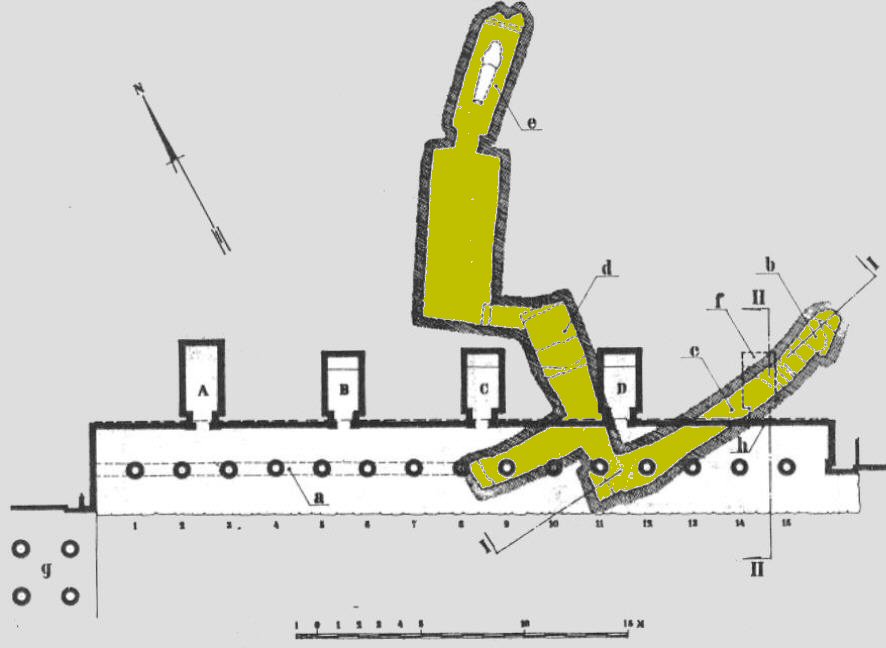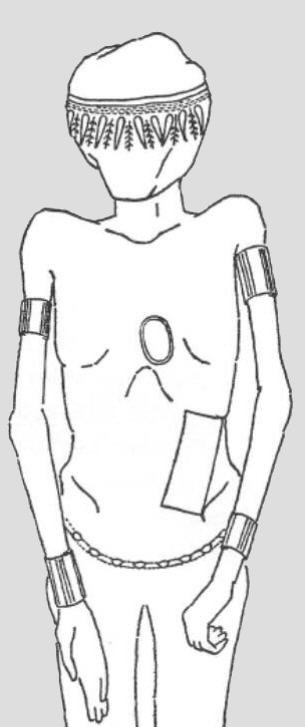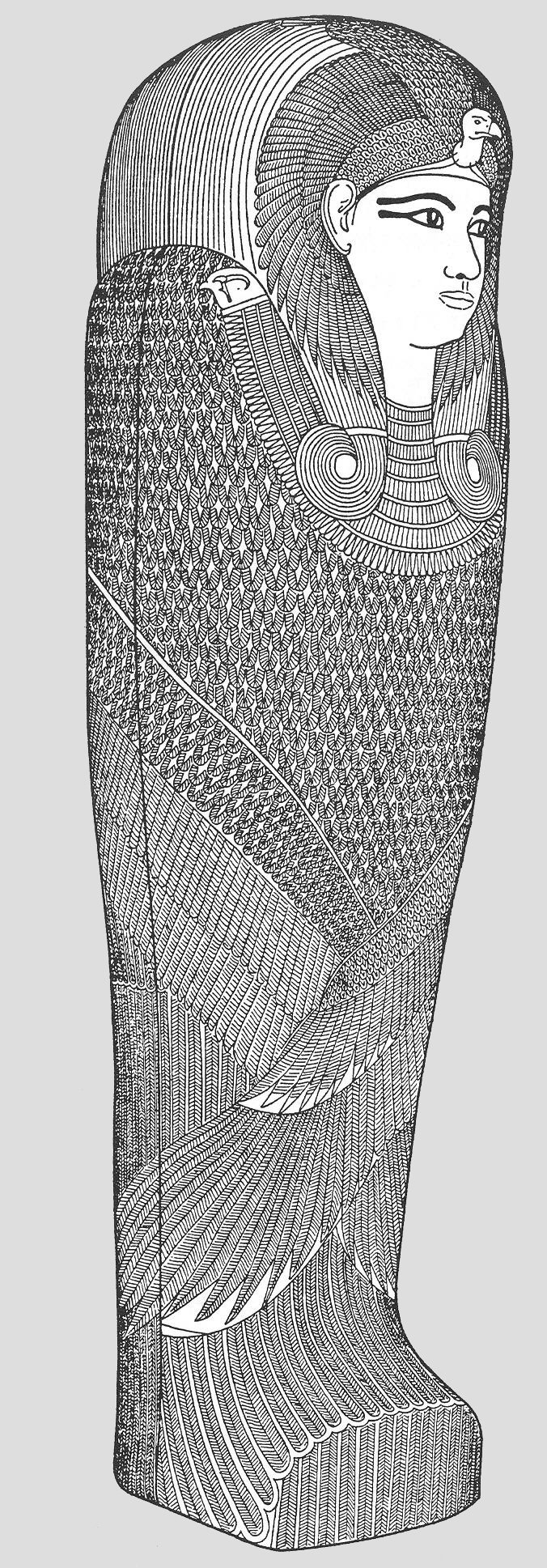|
The
tomb of Meryetamun, TT358 |
update:
29.08.2010
|

| Floor plan of the northern portico and the location of the
tomb TT358
of Merit-Amun (taken from Wysocki, 1985b; modified). |
| b - e |
|
B = entrance shaft to TT358; c = passage, d = well, e = burial chamber |
| g |
|
pillared hall in front of the Lower Chapel of Anubis |
| 1 - 15 |
|
Columns of the colonnade |
|
In 1929 Winlock discovered the partly plundered tomb of Queen Meryt-Amun which was entered by shallow
vertical shaft (b) located about 4.5 ms far from north-eastern corner of the
portico. |
|
The entrance passage (c) runs to the eastern corner of the northern portico,
stops under columns 11 and 12, turns north leading to a vertical shaft (d).
Shortly after the bend a smaller passage branches off to the west and ends below
columns 8 an 9. Behind the shaft there is another chamber which leads to the
burial chamber (e). |
| Between 4.5 and 5 m from the entrance the cutting of the roof
of the passage exposed the under side of the foundations of the back wall of the
northern portico. On the left, the passage was cut in to the foundation trench
exposing 25 cm in depth, and the roof the under sides of one or two foundation
block were exposed. However, since the passage descended at about 8 cm per meter
no further blocks were exposed. That none of the foundation stones had fallen
into the passage was explained by Winlock with the fact that the blocks were
tightly wedged together and that the mortar between them was fully hardened
before the passage was dug (Winlock, H.E., The Tomb of the Queen Meryet-Amun at Thebes. New York 1930). |
| Based on these observations Winlock concluded convincingly that
the northern portico was made before the tomb. Otherwise, if the tomb had been
in existence before the foundation trench was quarried out, the cutting down
into the shale probably would have cause a greater part of the passage roof to
collapse and it would not have been possible to put the large blocks of the
foundation across the opening without a supporting wall in the passage.
|
|
Although plundered Winlock discovered inside the tomb a lot of items indicating
that Meryet-Amun had been buried during the early 18th Dynasty. |
 |
|
 |
| The drawing above shows the
impressions of jewelry left on the mummy of
Meryet-Amun (taken from Winlock, loc. cit., figure. 1). The rectangular
impression on the left body-side was most likely cast by a plate which had been
placed by the embalmers over the 10 cms long incision. |
|
First (inner) coffin of Meryet-Amun
according to the reconstruction of the original decoration (taken from Winlock, loc. cit.,
figure. 4). |
| The mummy of Meryet-Amun is approx. 160 cm long and was buried
in a coffin made of cedar wood which was approx. 185 cms long, at maximum 52 cms
high, and 53 cms wide. The mummy had been robbed of its bandages and its
jewelries, however various pieces of jewelry had left impressions on the mummy.
During the restoration some of the destroyed bandages were thrown on a heap,
others were collected in boxes and baskets, which belonged to the original tomb
furniture. One strip carried name and title " God's wife, king's wife, Meryet-Amun,… ". Remarkable is the location of the incision (see left illustration
above) used for the withdrawal of the internal organs - a nearly perpendicular
cut between left, lower rib sheet and the hip - which is typical for the time
before Thutmosis III. |
|
Also the first coffin had been badly treated by tomb robbers and with the
painted restoration done in the 21st Dynasty bore no relation to the original
design. However, based on the investigations of Winlock the first coffin
followed the Rishi style representing a large bird with human head (see
illustration right above). Originally it had been covered inside and outside
with a very thin gold foil. |
|
The coffin restored in the 21st Dynasty showed on its front side a vertical
inscription of the usual offering formula. Winlock did not include this
inscription in his reconstruction of the original design. |
|
The first, inner coffin lay in a second coffin made of cedar wood which had the
gigantic length of approx. 313.5 cms, and was at maximum 87 cms wide. This
second coffin resembled the large coffin of Ahmes Nefertari in size and stile.
It is possibly that the face was to be seen in the naked wood without paint or
gilding. The hands my have left also in natural wood. |
|
Eyeballs (alabaster), pupils (obsidian), as well as the original eyebrows and
lids including the outside strips of the eyelids (all blue glass) had been
inlaid work. An enormous wig with sunken chevrons should represent braided hair,
shoulders and arms was covered of sunken feathers. The sunk areas still
contained plaster used to fasten of the inserted material, the raised areas
still traces of the gesso, which had been originally covered with gold leaf. In
the 21st Dynasty the restorers had painted yellow all the raised areas which had
been most likely originally covered with gold leaf. |
|
The remaining surface of the coffin was covered with glue and rows of nail holes
could be followed around the body down to the toes - probably part of the exterior had been
covered with thin gold foils in Rishi style. Also the entire inside of the
coffin
had been plated with thin metal foils held in place by glue alone. |
|
In the grave remainders of a third coffin made of tamarisk wood were found,
which had probably enclosed the two other coffins. So far it could be
reconstructed the third coffin was a colossal anthropoid coffin with a
large vulture head made of a coniferous wood like pine. The coffin was probably
completely covered with rough lines, on which a white stucco layer had been laid
on. The body was left perfectly plain, unless there was an inscription on the
front, but it there was one, no traces of it survived. |
|


